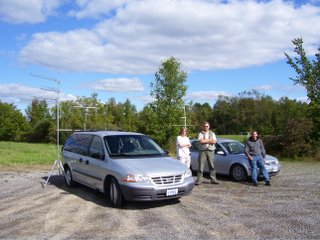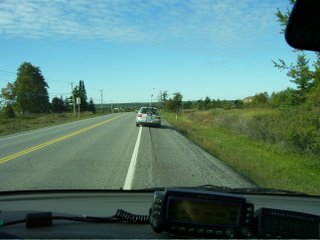HIT-SAT heard!
Yipee! Today I was able to hear the new amateur radio satellite called "HIT-SAT".
Hit-Sat is a new micro-sat put up by the Hokkaido Institute of Technology. Additional details can also be found on the AMSAT-UK site.
Here is a pic of HIT-SAT (before it was launched ;-) to give you an idea of how small it is:

Here is a pic of a CW transmission I was able to pick up on 437.275 Mhz during the 23:45 UTC pass over my QTH of Ottawa, Ontario.

My station consists of a Yaseu FT-847. The 432 antenna is a horizontal loop called the "E-Factor" that is produced by KU4AB and is on a chimney mount at about 35'. This is certainly not the ideal setup for receiving satilliete signals which explains the weak signal. However considering that HIT-SAT puts out about 200mw of power on the CW beacon I was just happy to hear it!
I was able to determine when HIT-SAT was overhead by using the free software package called "SatScape" which is an excellent program for tracking sats!
Here is a close up of the trace. I was "tuning" around looking for the signal when I finally heard it, which explain why this trace diagram show the signal frequency moving so quickly.

With a "real" satillete station this cw beacon should be very easy to hear and it wil be great once it is fully operational!
Hit-Sat is a new micro-sat put up by the Hokkaido Institute of Technology. Additional details can also be found on the AMSAT-UK site.
Here is a pic of HIT-SAT (before it was launched ;-) to give you an idea of how small it is:

Here is a pic of a CW transmission I was able to pick up on 437.275 Mhz during the 23:45 UTC pass over my QTH of Ottawa, Ontario.

My station consists of a Yaseu FT-847. The 432 antenna is a horizontal loop called the "E-Factor" that is produced by KU4AB and is on a chimney mount at about 35'. This is certainly not the ideal setup for receiving satilliete signals which explains the weak signal. However considering that HIT-SAT puts out about 200mw of power on the CW beacon I was just happy to hear it!
I was able to determine when HIT-SAT was overhead by using the free software package called "SatScape" which is an excellent program for tracking sats!
Here is a close up of the trace. I was "tuning" around looking for the signal when I finally heard it, which explain why this trace diagram show the signal frequency moving so quickly.

With a "real" satillete station this cw beacon should be very easy to hear and it wil be great once it is fully operational!







